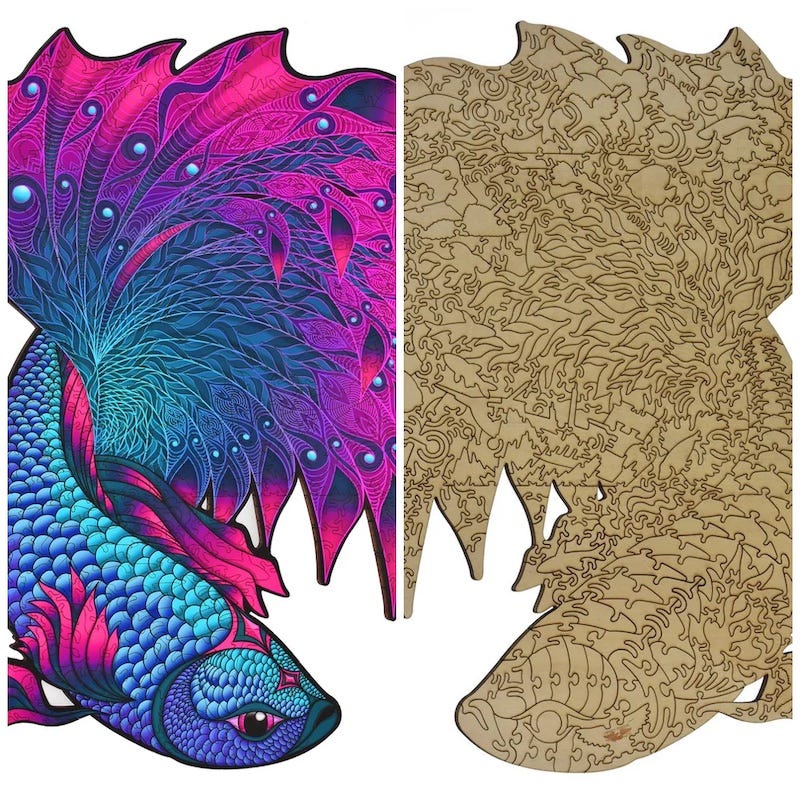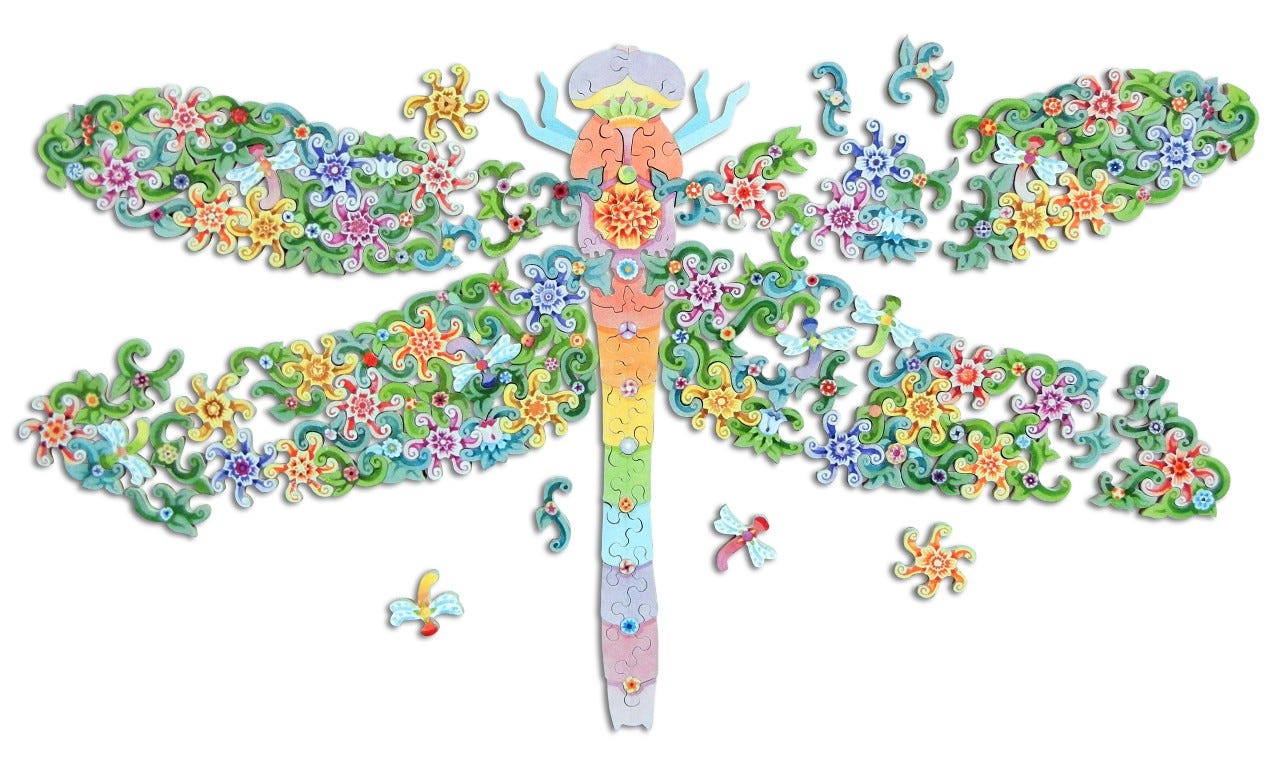Handmade Puzzles, and the Remarkable Craft of Dissectology
Our writer digs into the fascinating, unusually detailed world of handcrafted jigsaw puzzles—and the little-known word for their devotees.
Dear Friends,
Today, we’re departing briefly from our May theme (sustainable gardening) to bring you a new story by Craftsmanship’s contributing editor, Jeff Greenwald. Jeff has written many stories for this magazine on wonderfully diverse topics, including his recent profile of First Nations totem carver Mike Dangeli. In today’s release, you’ll meet some makers of intricately handcrafted jigsaw puzzles—and you might just learn a new word for what they do.
Next Friday, we’ll return to our gardening theme with a new episode of “The Secrets of Mastery.” So please, stay tuned.
We always welcome your thoughts and suggestions—which you can offer in a comment, by tagging us in Substack Notes, or via email. You can also find us on Facebook, Instagram, and YouTube. We put months of effort into our stories, so we thank you for reading and sharing them, for supporting our work with a paid subscription if you can, and for being such a loyal part of the Craftsmanship community.
Sincerely,
Todd Oppenheimer
Publisher & Editor-in-Chief, Craftsmanship Magazine

The Puzzling Craft of Dissectology
by
Few pursuits are more obliquely named than “dissectology.” The term calls to mind luckless amphibians, etherized in high school laboratory trays. But dissectology is a passion shared by such gentle luminaries as Queen Elizabeth II, Oprah, Bill Gates, and Patrick Stewart—none of whom would willingly harm a frog.
Dissectologists do not require pins, a scalpel, or forceps. What they need is a sharp eye, and the ability to see large patterns in small bits—for a dissectologist is a person who loves solving jigsaw puzzles. And this -ology would include, presumably, those who craft and create them.
British cartographer John Spilsbury invented the first jigsaw puzzle in the 1760s, as a learning aid for European geography. He glued a map of Europe to a sheet of thin wood and jigged out (“dissected”) each country. In the 260-odd years since, jigsaw puzzles have become a global obsession, estimated to generate $3 billion in revenue worldwide in 2024 alone. The world’s largest jigsaw puzzle has an astonishing 60,000 pieces, covering an area of 232 square feet.
But the fascination of solving a jigsaw puzzle is not simply a function of the piece count; the visual pattern is the greatest challenge. Consider assembling a puzzle depicting the U.S. Constitution, as opposed to an image of a roiling sea.
In the U.S., at least a dozen companies are crafting artisan puzzles with fine materials and intricate pieces. Such puzzles are priced as befits their complexity; a hand-cut, 3D jigsaw by Stave Puzzles, in Vermont, can cost up to $10,000, while the vivid, mind-bending selections from Liberty Puzzles (in Colorado) top out at around $250.
“About 80 percent of the puzzles we offer are in the 500-piece range; that’s the best group adult project for one to two nights,” says Chris Wirth, who co-founded Liberty with Jeff Eldridge.
Wirth has a personal connection to dissectology. His great-grandmother befriended the owners of Chagrin Falls wooden puzzles. Jigsaw puzzles became an affordable pastime during the Great Depression—an era when, according to Liberty’s website, “30 million households in the U.S. were absorbing 10 million jigsaw puzzles a week.” More than 100 of Chagrin Falls’ puzzles were bequeathed to Wirth’s family, and assembling them became an indelible part of his childhood.
Finding puzzle-worthy art is the first step. “I know a good jigsaw image when I see it,” Wirth told me, as I perused the designs on Liberty’s website. Wirth and Eldridge initially thought Liberty would do well making custom puzzles, but found that most of the photos they received from customers were too drab.
Certain artists have a knack for puzzle imagery. One of these is Phil Lewis, a former rock band bassist who has illustrated more than 20 of Liberty’s puzzles. “I make artwork as it comes to me,” he says, “and those guys take it from there.” Lewis’s images are inspired by, among other things, psychedelia and the Grateful Dead; his puzzles, with names like Seven Chakras and Let it Flow (the “line-cut” puzzle shown above, in the shape of a brilliantly hued betta fish) are stunning just visually.
Art is central to a jigsaw puzzle. But if you turn a completed puzzle over (not so easy to do!) you’ll see where the craft lies. The matrix of a puzzle’s pieces and how they all fit together is called the “cut pattern,” and requires expertise of a different sort. The mind behind Liberty’s cut patterns is illustrator Lynon Aksamit, a graduate of the Rocky Mountain School of Design who has worked with Wirth and Eldredge for more than 17 years.
“After a decision is made about the image,” Aksamit said. “The first thing I think about is the ‘whimsy’ pieces.”
Whimsies are a cut pattern designer’s joy. These elements—silhouette pieces that may comprise 25 percent of a puzzle’s piece count—are far from the standard knobs-in-sockets of traditional puzzles. For the whimsies in Let it Flow, Aksamit found aquatic inspiration: fish, coral, dragonflies, shipwrecks. In Seven Chakras, the whimsy pieces include a maze of Sanskrit letters, yoga asanas, and floral spirals. And for Sugar Magnolia, a Phil Lewis design based on a Grateful Dead song, whimsies include dancing skeletons with top hats.
“It's as many whimsy pieces as we can fit,” says Chris Wirth. “Then Lynon will draw what we call ‘ear-lip’ pieces. They often look like little ears, and connect all the whimsy pieces… every piece that's not a whimsy piece is touching a whimsy piece.”
After Aksamit creates the cut pattern for a specific puzzle, he’ll trace it onto a screen with a stylus. The file is then sent to Liberty. There, the puzzle’s image is adhered to a 3-ply wooden panel, and Aksamit’s pattern is used to program the laser—with a beam the breadth of a human hair—that cuts the pieces.
“It’s laser-cut, but it's very crafty,” says Wirth. Since wood is seldom uniform, some pieces might be denser, or otherwise problematic. “Each puzzle requires a lot of TLC, particularly as it’s being taken apart. That's a very important quality control step; each puzzle is touched by 10 or 12 sets of hands during the process.”
“But once the person who's taking it apart gets all 500 pieces on their table,” he says, “they just sweep it into the box.”
Liberty’s laser-cut jigsaws are beautiful and affordable, priced in the $100 to $250 range. But for those who can spend up to $10,000 on a puzzle, there is a whole different level in terms of both difficulty and craftsmanship.
Stave Puzzles was founded in Vermont in 1974 by Steve Richardson and Dave Tibbetts (Steve + Dave = “Stave”). Tibbets soon bowed out, and Richardson’s unique genius as a jigsaw “tormentor” came into its own.
“Steve has a brain like nobody else’s,” says Stave president Jennifer Lennox, who took over when Richardson retired. “He wasn’t satisfied with cutting traditional puzzles; he always came up with new and different things to challenge our puzzlers.”
These include Stave’s hand-painted, Limited Edition puzzles based on stories like “A Midsummer Night’s Dream”; Teaser™ puzzles with negative space (or “dropouts”) between pieces; Trick™ puzzles, with pieces that have multiple ways of fitting together, but only one solution; and Touzzles™: borderless “Trick” puzzles with 3D assemblies that rise off the table surface. “Your challenge is to make order out of chaos as you battle wits with piles of pieces that are intentionally the same color or shape.”
“There are no lasers at Stave,” says Lennox, herself a practiced cutter. Each puzzle is cut from 5-ply, cherry-backed wood, using a scroll saw with blades “comparable in thickness to the hair of a horse’s tail.” All puzzle pieces—whimsies and ear-lips alike—are cut freehand, without a template. Each of Stave’s cutters spends months in training and has a signature style, like handwriting. Colleagues can often tell who cut a puzzle just by looking at the cut pattern.
“There’s much more freedom in cutting the puzzle by hand,” says Lennox. “A real person is sitting at that saw, making the decisions: I can go left or right when I start cutting. Do I want to cut the interlock pointing downward or upward? Is there a color-line I could be following to make this puzzle harder for the puzzler? How should I approach that person’s face? Does the customer want their black Labrador and Maine Coon cat as puzzle pieces? Or the names of their grandchildren?”
“Being a puzzle cutter is the best job ever!” she says. “I don’t get as much time on the saw as I used to—but if I’m having a day where it seems like I’m accomplishing nothing, I’ll hop on the saw and do some cutting. It’s so neat to sit down with a single piece of wood, and watch it transform into a bunch of beautiful pieces.”
As a final note, I was curious to know what jigsaw aficionados—the very people I spoke with for this story—think of the word used to define them. Turns out, it’s as Greek to them as it was to me.
“I am hearing the word ‘dissectology’ for the first time,” says Molly Delaney, a puzzle designer for Stave for some 25 years. “What does it mean?”
“I would not use that word myself in any context,” says Liberty’s Chris Wirth. “Although I certainly am one.”
“Yeah, that makes sense,” says whimsy designer Lynon Aksamit, also pondering the word for the first time. “It’s cool. I like it.”








